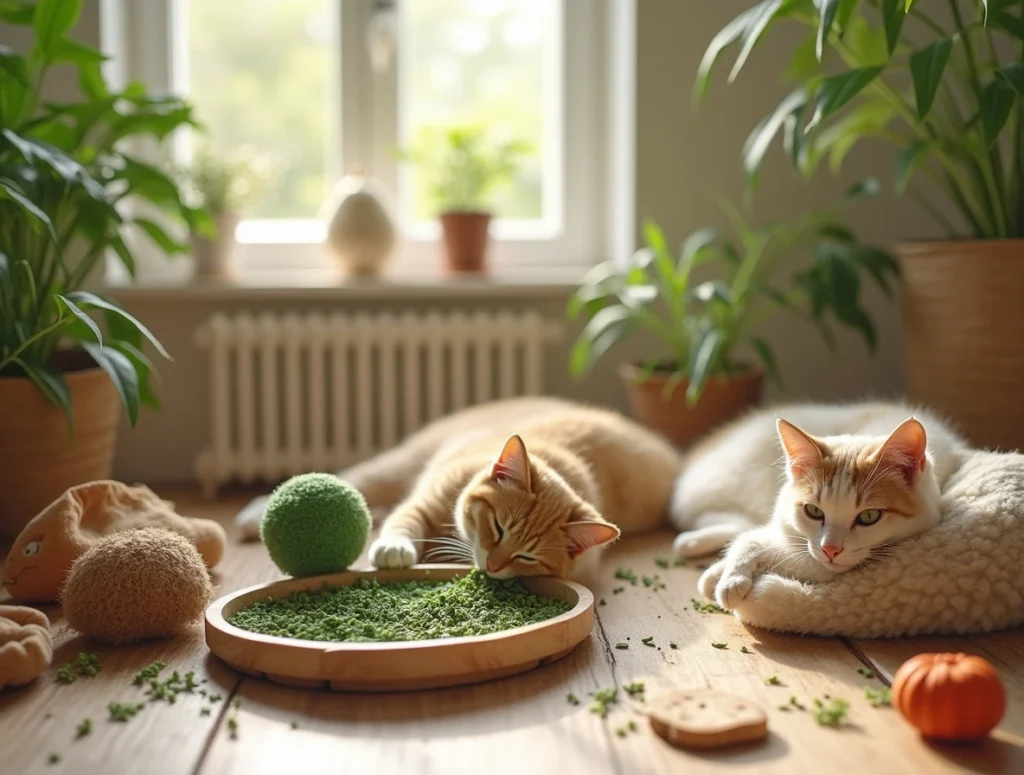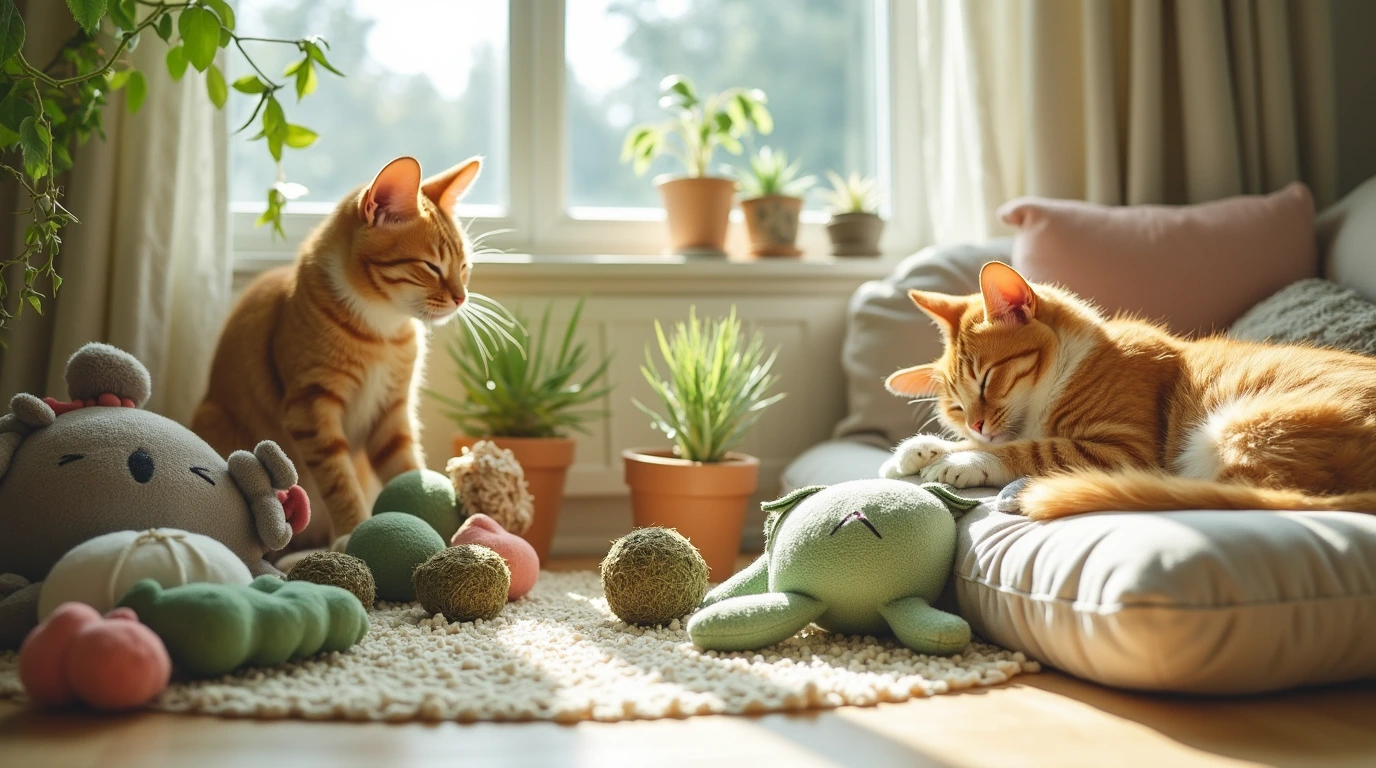As a cat owner, you understand the joy of seeing your furry companion pounce on their favorite toy, roll around in pure bliss, or gleefully munch on a tasty treat. But have you ever stopped to think about what’s inside those toys and treats? The quality of the materials and ingredients you choose can make a significant difference in your cat’s health and well-being. One product that stands out for its combination of fun and natural benefits is organic catnip. This guide will explore everything you need to know about organic catnip toys and treats—why they’re essential, how to choose the best ones, and what to expect when you introduce them to your cat.
Table of Contents
What Is Organic Catnip and Why Does It Matter?
Understanding Organic Catnip: The Basics
Organic catnip, or Nepeta cataria, is a member of the mint family that has long been known for its ability to trigger euphoric reactions in cats. While catnip is commonly associated with a short burst of excitement, the reality is that its effects are not just fun—they’re also beneficial for your cat’s health.
But what sets organic catnip apart from its conventional counterpart? Organic catnip is grown without the use of synthetic pesticides, herbicides, or artificial fertilizers. This ensures that the plant remains as close to its natural state as possible, making it a safer and healthier option for your pet.

Why Organic Matters for Your Cat
- Free from Harmful Chemicals: Regular catnip may contain traces of pesticides and chemicals that are harmful to your pet. Organic catnip, on the other hand, is grown using eco-friendly methods that prioritize your cat’s safety.
- Better Potency: Organic catnip is often more potent than non-organic varieties because it’s grown in healthier soil, leading to a higher concentration of essential oils—the active ingredient that causes the euphoric reaction.
- Environmentally Friendly: Choosing organic products helps support sustainable farming practices that benefit the environment, making it a win-win for your cat and the planet.
The Benefits of Organic Catnip Toys & Treats
Organic catnip isn’t just an enjoyable experience for your cat—it comes with a wide range of benefits. Whether you’re looking to reduce stress, encourage exercise, or offer a natural treat, organic catnip toys and treats are an excellent choice for your pet’s overall well-being.
1. Stress Relief and Anxiety Reduction
Many cats experience anxiety, whether from changes in their environment, vet visits, or separation from their owners. Organic catnip has natural calming properties that can help soothe your cat and reduce stress. A small amount of catnip can trigger a feeling of relaxation, which is especially helpful for cats who suffer from separation anxiety or fear-based behaviors.
2. Encourages Exercise and Mental Stimulation
Interactive catnip toys, like catnip-filled balls or wands, encourage your cat to stay active and mentally engaged. Active play helps reduce the risk of obesity and keeps your cat physically healthy. These toys can also help combat boredom, which is crucial for keeping your cat’s mind sharp.
3. Supports Digestive Health and Overall Well-being
Organic catnip treats made from high-quality ingredients can support your cat’s digestive health. Catnip is known to aid in digestion, and when included in treats, it can help soothe your cat’s stomach, especially if they have mild digestive issues. Organic treats are also free from artificial additives, preservatives, and harmful chemicals, making them a healthier option for your cat.
4. Safe for Sensitive Cats
If your cat has a sensitive stomach or is prone to allergies, organic catnip is the best choice. It’s free from the pesticides and chemicals found in non-organic catnip, making it a safer option for cats with allergies or sensitivities to synthetic substances.
Top Organic Catnip Toys for Every Cat Personality
Not all cats are the same, and the right toy for your cat will depend on their play style and personality. Organic catnip toys come in many forms, from interactive toys to solo play options, so you can find the perfect one for your cat.
Best Organic Catnip Toys for Active Cats
If your cat is energetic and loves to run, jump, and chase, interactive catnip toys are the way to go. These toys are designed to stimulate your cat’s physical activity, helping them burn off energy and stay fit.
Popular choices for active cats include:
- Catnip Balls: Perfect for rolling around and batting, these toys can keep your cat entertained for hours.
- Catnip Wands: These toys typically feature a dangling catnip-filled toy that moves with the pull of a string, providing your cat with both mental and physical stimulation.
- Interactive Puzzles: Some catnip toys come in puzzle form, requiring your cat to figure out how to reach the treat or catnip inside. These engage your cat’s brain while also providing a healthy challenge.
Best Organic Catnip Toys for Relaxed Cats
For cats who are less active or prefer quiet, solitary play, there are also softer, comforting catnip toys that promote relaxation and calmness.
Recommended toys for laid-back cats include:
- Catnip Plushies: Soft, cuddly toys filled with organic catnip are perfect for cats who enjoy lounging. These toys often have a calming effect, encouraging your cat to curl up and nap.
- Catnip Pillows: Small, soft pillows filled with organic catnip can be placed in your cat’s favorite resting spots for a relaxing experience.
- Catnip Tunnels: For cats who love to hide and explore, a catnip-filled tunnel can provide both comfort and stimulation, helping your cat feel secure while enjoying the soothing effects of catnip.
Organic Catnip Treats: A Healthier Snack for Your Cat
Organic catnip treats provide a delicious and healthy alternative to traditional store-bought cat treats, which may contain harmful additives and preservatives. These treats are a great way to spoil your cat while giving them a nutritional boost.
How to Choose the Best Organic Catnip Treats
When selecting organic catnip treats, there are a few key factors to keep in mind:
- Ingredient Quality: Always opt for treats made with organic ingredients, including organic catnip, whole grains, and other natural flavors. Avoid treats with artificial colors, preservatives, or by-products.
- Certifications: Look for certifications like the USDA Organic seal or other reputable organic certifications. These ensure the product is genuinely organic and free from harmful chemicals.
- Texture and Taste: Choose between soft and crunchy treats based on your cat’s preferences. Some cats prefer chewy treats, while others enjoy crunchy snacks.
Homemade Organic Catnip Treats Recipe
If you enjoy making homemade treats for your cat, here’s a simple recipe that combines organic catnip with wholesome ingredients:
| Ingredient | Amount |
|---|---|
| Organic catnip | 1 tbsp |
| Organic oat flour | 1/2 cup |
| Organic wheat flour | 1/2 cup |
| Organic egg (beaten) | 1 |
| Organic coconut oil (melted) | 2 tbsp |
| Water (as needed) | 1-2 tbsp |
Instructions:
- Preheat your oven to 350°F (175°C).
- In a bowl, combine the oat flour, wheat flour, and organic catnip.
- Add the beaten egg and melted coconut oil.
- Gradually add water to form a dough-like consistency.
- Roll the dough into small balls or use a cookie cutter for fun shapes.
- Bake for 10-12 minutes, then allow them to cool before serving.
How to Introduce Organic Catnip Toys & Treats to Your Cat
Introducing organic catnip toys and treats to your cat can be a fun and exciting experience for both you and your pet. However, it’s important to proceed slowly and observe your cat’s reactions to ensure they enjoy the new addition to their routine.
Tips for Introducing Toys:
- Start Slow: Introduce new toys one at a time. Place the toy in your cat’s favorite area, and allow them to explore it at their own pace.
- Engage in Play: Use the toy to engage your cat in interactive play. Waving a catnip wand or tossing a catnip ball can trigger excitement and curiosity.
- Observe Reactions: Not all cats respond to catnip in the same way. Some cats may become playful and energetic, while others may prefer to relax. Watch your cat’s behavior to gauge their preference.
Tips for Introducing Treats:
- Begin with Small Amounts: If you’re giving your cat organic catnip treats for the first time, start with a small amount and monitor their reaction.
- Use as a Reward: You can use catnip treats as an occasional reward during training sessions or simply as a treat between meals.
- Keep Moderation in Mind: While organic catnip treats are healthy, they should be given in moderation to prevent overindulgence.
Are Organic Catnip Toys & Treats Safe for All Cats?
While organic catnip toys and treats are generally safe for most cats, there are a few considerations to keep in mind:
Kittens and Senior Cats:
- Kittens: Kittens under six months of age may not respond to catnip, as they lack the receptors needed to feel its effects.
- Senior Cats: Older cats may enjoy catnip, but their reactions can be less intense than younger cats. Always monitor their behavior when introducing new products.
Cats with Health Conditions:
If your cat has a medical condition, such as digestive issues or allergies, consult with your vet before introducing catnip-based products. Some cats may be more sensitive to certain ingredients, so it’s always best to err on the side of caution.
Frequently Asked Questions (FAQs) About Organic Catnip Toys & Treats
1. What is the difference between organic and non-organic catnip?
The key difference between organic and non-organic catnip lies in the way it’s grown. Organic catnip is cultivated without the use of synthetic pesticides, herbicides, or fertilizers, making it a healthier and safer option for your cat. It also tends to have a richer concentration of essential oils, which are responsible for the euphoric effect that catnip has on cats. Non-organic catnip, on the other hand, may contain trace chemicals or pesticides that can be harmful to your cat over time.
2. Is organic catnip safe for all cats?
Yes, organic catnip is generally safe for most cats. However, not all cats are affected by catnip. Around 50-70% of cats are sensitive to catnip, with some becoming playful and energetic, while others may feel calm or relaxed. Kittens under six months old may not respond to catnip yet, as their receptors haven’t fully developed. Senior cats may also show a less intense reaction. If your cat has a health condition, it’s always best to consult your vet before introducing catnip.
3. How do I know if my cat likes organic catnip toys or treats?
If your cat is sensitive to catnip, they may react by becoming excited, rolling around, purring, or even drooling. On the other hand, some cats may simply sniff the catnip and walk away, showing no particular interest. If your cat doesn’t respond to catnip at first, don’t be discouraged—it’s not uncommon for some cats to be indifferent to it. Keep trying different forms of catnip (e.g., toys, sprays, or treats) and see if they prefer one over another.
4. How can I introduce organic catnip to my cat?
Start by offering your cat small amounts of organic catnip, either in the form of toys or treats. Place the toy or treat in a familiar, safe space where your cat feels comfortable. Let your cat explore it on their own, and observe how they react. Interactive toys like catnip wands can engage them in active play, while catnip-filled plush toys or pillows can offer a more relaxing experience. If you’re giving them organic catnip treats, start with a small piece to gauge their reaction.
5. Can organic catnip treats help with my cat’s digestion?
Yes! Organic catnip has natural digestive properties that can help soothe your cat’s stomach. It can aid in easing mild digestive issues and encourage healthy digestion. Many organic catnip treats are formulated with other digestive-friendly ingredients, such as organic oats and wheat flour. However, catnip should not replace a proper diet or medical treatment. If your cat has ongoing digestive problems, consult your veterinarian.
6. How much organic catnip is safe for my cat?
Organic catnip is safe for most cats when given in moderation. While it’s generally non-toxic, too much catnip can cause mild gastrointestinal upset, such as vomiting or diarrhea. For toys: You can leave a catnip toy out for your cat to enjoy as often as they like. For treats: Limit them to a few per day, depending on your cat’s weight and overall diet. Always monitor your cat’s reaction, and if they show signs of overeating or discomfort, reduce the amount of catnip you provide.
7. Are there any side effects of organic catnip?
In general, organic catnip is safe for most cats. However, overindulgence can sometimes lead to mild digestive upset. Some cats may become overly excited, which can lead to hyperactivity or aggression. If you notice your cat acting out of character after exposure to catnip, it may be best to reduce the amount you give them.
8. What are the best organic catnip toys for indoor cats?
Indoor cats can benefit greatly from organic catnip toys that stimulate both their body and mind. Catnip wands are excellent for interactive play, allowing you to engage with your cat in a fun, exercise-promoting way. Catnip-filled balls and interactive puzzles can encourage your cat to chase and explore, helping them stay active even when they don’t have access to outdoor space. Catnip tunnels can also provide a cozy hiding space and stimulate natural hunting behaviors.
9. How can organic catnip help with my cat’s behavior issues?
Organic catnip can help alleviate certain behavior issues like anxiety, stress, and boredom. If your cat is stressed, especially after changes in their environment (like moving to a new home), introducing organic catnip can provide a calming effect. Catnip can also help relieve boredom, which may reduce destructive behaviors like scratching furniture or excessive meowing. For cats with more severe behavioral issues, it’s important to consult with a veterinarian to rule out underlying health problems.
10. Can I make my own organic catnip toys at home?
Yes! Making your own organic catnip toys is a fun and easy project. You can create simple toys by filling small fabric pouches or old socks with organic catnip and securely stitching them closed. You can also make catnip-stuffed pillows or balls by sewing or gluing fabric together. There are plenty of DIY tutorials available online that can guide you through the process. Homemade toys allow you to control the quality of the ingredients and customize the toys to your cat’s preferences.
Conclusion: Give Your Cat the Best with Organic Catnip Toys & Treats
Organic catnip toys and treats are more than just a fun indulgence—they’re a healthier, safer, and more environmentally friendly choice for your cat. From providing stress relief to encouraging physical activity, organic catnip products offer numerous benefits for your furry friend. By choosing organic, you’re ensuring that your cat enjoys a high-quality, natural experience while minimizing exposure to harmful chemicals.
Take the next step: Try organic catnip toys and treats today and watch your cat’s playful side come to life. Whether you’re looking to reduce stress, encourage exercise, or just spoil your cat with a delicious treat, organic options are the way to go for a healthier, happier feline companion.

